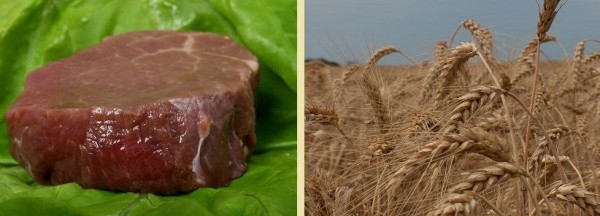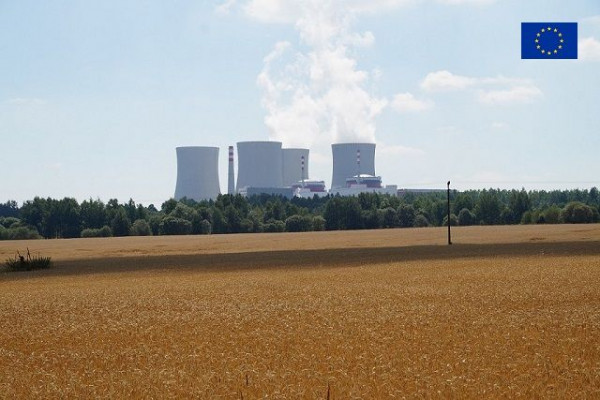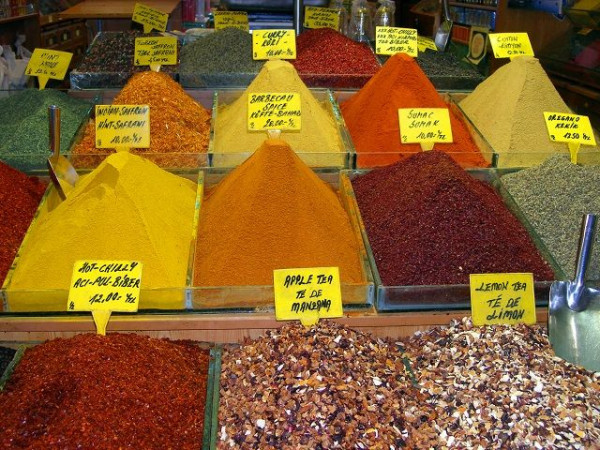Find out at a glance our ALS analytical solutions for food in this leaflet.
Levels of radionuclides in food are mainly monitored in relation to the consequences of nuclear accidents and nuclear weapons testing.

The releases from nuclear reactor accidents contain a great amount of the short-lived radioisotopes and tritium.

Emergency services – artificial radionuclides
ALS is able to determine those radionuclides with very short half-lives:
- Tellur 132
- Iodine 132
- Ruthenium 103
- Barium 140
- Lanthan 140
- Zirconium 95
- Niobium 95
- Cesium 136
ALS Monitoring of artificial radionuclides in food, biota, soil and water during the first several days after a nuclear accident is valid for samples 4 days old. The delivery of results is under 3 days after delivery to the laboratory.
| Radionuclide | Regulation | ALS LOR | Volume | |
| Dairy produce (Bq/kg-L) | other foodstuffs except minor foodstuffs (Bq/kg or Bq/l) | (Bq/kg-L) | ||
| I-131 | 500 | 2000 | 5 | 100ml |
| Te-132/I-132 | 500 | 2000 | 10 | |
| Ru-103 | 1000 | 1250 | 5 | |
| Cs134 | 1000 | 1250 | 5 | |
| Cs-136 | 1000 | 1250 | 5 | |
| Cs-137 | 1000 | 1250 | 5 | |
| Ba-140/La-140 | 1000 | 1250 | 30 | |
| Zr-95 | 1000 | 1250 | 20 | |
| Nb-95 | 1000 | 1250 | 20 | |
However, after a few weeks, the predominant radionuclides will be Cs-134 and Cs-137.
Sr-90 and Cs-137 are by-products of the fission of uranium and plutonium in nuclear reactors and in nuclear weapons. Sr-90 is found in waste from nuclear reactors.
Caesium 134, Caesium 137: Cs-137 is considered the most problematic of the short-lifetime fission products because it easily moves and spreads in nature, mainly to water. Together with Cs-134, I-131, Sr-90, Cs-137 was among the isotopes distributed by reactor explosion that constitute the greatest risk to health.
Potassium 40 is known as the largest source of natural radioactivity in animals including humans. It ranks third after Th-232 and U-238 radioactive decay in the soil.
The dose to human is around 20 mrem/year due to the K-40 in the body and 10 mrem/year due to the gamma rays emitted by K-40 from the soil.
The human body maintains relatively tight homeostatic control over potassium levels. This means that the consumption of foods containing large amounts of potassium will not increase the body’s potassium content. This is the reason, why the gross beta activity is often corrected to potassium 40.
As Strontium 90 belongs to the same group IIA like calcium, it behaves like calcium and therefore tends to concentrate in the bones and teeth of animals and human beings.
At ALS, HRGRS (High resolution gamma spectrometry) is used for the determination of 131I, 137Cs, 137Cs, 241Am and 40K, and radiochemical methods are used for the determination of 90Sr. ICP/SFMS is used for the determination of U, Th and Pu isotopes.
Legislation on food and feed - EURATOM

COUNCIL REGULATION NO. 3954/87 (EURATOM) of 22nd December 1987 lays down maximum permitted levels of radioactive contamination of foodstuffs and of feeding stuffs following a nuclear accident or any other case of radiological emergency.
The Regulation 3954/87 was completed by two complementary Regulations, the Regulation No. 944/89 of 12. April 1989 laying down maximum permitted levels of radioactive contamination in minor foodstuffs following a nuclear accident or any other case of radiological emergency and Regulation No. 770/90, the Commission Regulation of 29. March 1990, laying down maximum permitted levels of radioactive contamination of feedingstuffs following a nuclear accident or any other case of radiological emergency.
The annex of Regulation 3954/87 sets maximum permitted levels for foodstuffs. Foodstuffs, which are not in compliance with these maximum permitted levels shall not be placed on the market:
| Maximum levels Bq/kg or Bq/l | Foodstuffs(1) | Activity concentration reached in ALS | |||
| Baby food (2) | Dairy produce (3) | Other foodstuffs except minor foodstuffs (4) | Liquid foodstuffs (5) | ||
| Isotopes of strontium, notably Sr-90 | 75 | 125 | 750 | 125 | 5 |
| Isotopes of iodine, notably I-131 | 150 | 500 | 2000 | 500 | 1 |
| Alpha-emitting isotopes of plutonium and trans-plutonium elements, notably Pu-239, Am-241 | 1 | 20 | 80 | 20 | 1? |
| All other nuclides of half-life greater than 10 days, notably Cs-134, Cs-137 (6) | 400 | 1000 | 1250 | 1000 | 5 |
- The level applicable to concentrated or dried products is calculated on the basis of the reconstituted product as ready for consumption. Member States may make recommendation concerning the diluting conditions in order to ensure that the maximum permitted levels laid down in this Regulation are observed.
- Infant food is defined as those foods intended for the feeding of infants during the first four to six months of life, which meet, in themselves, the nutritional requirements of this category of person and are put up for retail sale in packages which are clearly identified and labelled “food preparation for infants”.
- Dairy produce is defined as those products falling within the following CN codes including, where appropriate, any adjustments which might be made to them later: 0401, 0402 (except 0402 29 11).
- Minor foodstuffs and the corresponding levels to be applied to them are defined in accordance with Article 9.
- Liquid foodstuffs as defined in the heading 2009 and in chapter 22 of the combined nomenclature. Values are calculated taking into account consumption of tap-water and the same values should be applied to drinking water supplies at the discretion of competent authorities in Member States.
- Carbon14, tritium and potassium 40 are not included in this group.
The annex of the Regulation No. 770/90 sets maximum permitted levels of radioactive contamination (caesium‑134 and caesium-137) of feeding stuffs:
| Animal | Bq/kg (1,2) | Activity concentration reached in ALS (Bq/kg) |
| Pigs | 1250 | 5 |
| Poultry, lambs, calves | 2500 | 5 |
| Other | 5000 | 5 |
- These levels are intended to contribute to the observance of the maximum permitted levels for foodstuffs; they do not alone guarantee such observance in all circumstances and do not lessen the requirements for monitoring contamination levels in animal products destined for human consumption.
These levels apply to feeding stuffs as ready for consumption.
Decision on Food Safety – Customs Union
In the Republic of Belarus, Kazakhstan and the Russian Federation, Customs Union has decided to adopt a Technical regulation on Food safety (18. November 2010). This technical regulation came into force on 1st July 2013.

The unofficial translation of the Customs Union's technical regulation is available here.
The annex 4 of the Technical regulation of the Customs Union on Food Safety (TR TS 021/2011) specifies maximum allowable levels of radionuclides Cesium-137 and strontium-90:
| Groups of food products | Specific activity of Cesium-137 (Bq/kg or l) | Activity concentration reached in ALS (Bq/kg) | Specific activity of strontium-90 (Bq/kg or l) | Activity concentration reached in ALS (Bq/kg) |
| Meat, meat products and by-products | 200 | 5 | - | 5 |
| Venison, game | 300 | 5 | - | 5 |
| Fish and fish products | 130 | 5 | 100 | 5 |
| Dried fish and stockfish | 260 | 5 | - | 5 |
| Milk and products of milk processing | 100 | 5 | 25 | 5 |
| Concentrates of dairy proteins, lactulose, lactose, casein, caseinates, hydrolisates of dairy proteins | 300 | 5 | 80 | 5 |
| Products of milk processing, dry, freeze-dried | 500 | 5 | 200 | 5 |
| Cheese and cheese products | 50 | 5 | 100 | 5 |
| Products of milk processing, concentrated, condensed; dairy, composite dairy, milk-containing canned food products | 300 | 5 | 100 | 5 |
| Butter, butter paste from cow milk, milk fat | 200 (for milk fat 100) | 5 | 60 (for milk fat 80) | 5 |
| Cream-and-vegetable spread, cream-and-vegetable melted mixture | 100 | 5 | 80 | 5 |
| Dry nutritional media on a milk basis | 160 | 5 | 80 | 5 |
| Vegetables, root crops including potatoes | 80 (600(2)) | 5 | 40 (200(2)) | 5 |
| Bread and bake goods | 40 | 5 | 20 | 5 |
| Flour, grits, meals, cereals, alimentary products, | 60 | 5 | - | 5 |
| Wild berries and preserved wild berry products | 160 (800(2)) | 5 | - | 5 |
| Fresh mushrooms | 500 | 5 | - | 5 |
| Dried mushrooms | 2500 | 5 | - | 5 |
| Specialized baby foods ready to serve(1) | 40 | 5 | 25 | 5 |
| Vegetable oils | 40 | 5 | 80 | 5 |
| Oils (fats) interesterified refined deodorized; oils (fats) hydrogenated refined deodorized; margarines; special purpose fats, including cooking, 2confectionary, and baking fats; milk fat replacers; cocoa butter equivalents, cocoa butter improvers of SOS-type, cocoa butter substitutes of POP-type, non-tempering cocoa butter substitutes, vegetable-and-fat spread, vegetable-and-fat melted mixtures, sauces on the basis of vegetable oils, mayonnaises, mayonnaise sauces, creams based on vegetable oils |
60 | 5 | 80 | 5 |
| Vegetable-and-cream spreads, vegetable-and-cream melted mixtures | 100 | 5 | 80 | 5 |
In case of freeze-dried products, the specific activity is determined for a reconstituted product;
permissible level for a dry product

